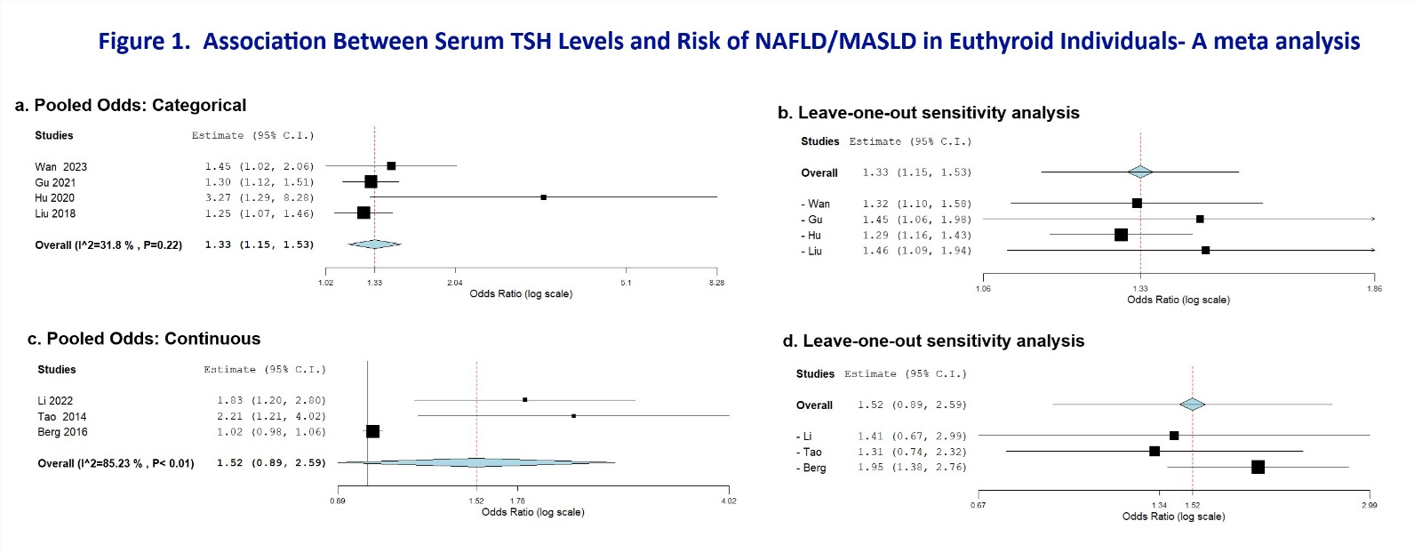Monday Poster Session
Category: Liver
P3783 - Higher TSH Within the Normal Range Is Linked to Increased Risk of NAFLD/MASLD in Euthyroid Individuals: A Meta-Analysis
Monday, October 27, 2025
10:30 AM - 4:00 PM PDT
Location: Exhibit Hall

Pratiksha Shankarlal Nathani, MBBS
St. Barbanbas Hospital
New York City, NY
Presenting Author(s)
Pratiksha Shankarlal Nathani, MBBS1, Moulika Kari, MBBS2, Vaishnavi Kanisetti, MBBS3, Helai Hussaini, MD4, Ankitkumar R. Patel, MBBS5, Shashank Gupta, MBBS6, Shrutik P. Borda, MBBS7, Anushka Dhabuwala, MBBS8, Rupak Desai, MBBS9
1St. Barbanbas Hospital, New York City, NY; 2Maimonides Medical Center, New York City, NY; 3Bhaskar Medical College, Hyderabad, Telangana, India; 4west anaheim medical center, Anaheim, CA; 5Narendra Modi medical college, Ahmedabad, Gujarat, India; 6Mayo Clinic, Brentwood, CA; 7Narendra Modi Medical College, Ahmedabad, Gujarat, India; 8Government Medical College, Surat, Valhalla, NY; 9Independent Outcomes Researcher, Atlanta, GA
Introduction: Thyroid function may influence liver fat metabolism, even within the normal (euthyroid) range. However, the link between serum thyroid-stimulating hormone (TSH) levels and the risk of non-alcoholic fatty liver disease (NAFLD), now termed metabolic dysfunction-associated steatotic liver disease (MASLD), remains unclear in euthyroid adults. This meta-analysis aimed to assess this association using both continuous and categorical TSH levels.
Methods: A systematic review was conducted in accordance with PRISMA guidelines. PubMed, Embase, Scopus, and Google Scholar databases were searched through May 2025 using terms including "euthyroid," "TSH," "thyroid-stimulating hormone," "NAFLD," and "MASLD." Studies were eligible if they evaluated the association between serum TSH and NAFLD/MASLD among euthyroid adults. Two independent reviewers performed data extraction and quality assessment using the Newcastle-Ottawa Scale. Meta-analyses were performed using a random-effects model, with pooled odds ratios (ORs) and 95% confidence intervals (CIs). Continuous and categorical TSH levels were analyzed separately. Heterogeneity was assessed using I² statistics, and leave-one-out sensitivity analysis was conducted.
Results: The meta-analysis included seven studies, comprising 37,625 euthyroid individuals. In the categorical analysis, higher serum TSH levels were significantly associated with increased odds of NAFLD/MASLD (pooled OR: 1.33, 95% CI: 1.15–1.53, I² = 31.8%, p = 0.22). Effect estimates ranged from 1.29 to 1.46 in leave-one-out sensitivity analysis, indicating no single study unduly influenced the overall result. In the continuous analysis, each unit increase in TSH was associated with higher odds of NAFLD/MASLD (pooled OR: 1.52, 95% CI: 0.89–2.59), though substantial heterogeneity was observed (I² = 85.2%, p < 0.01). Sensitivity analysis showed that excluding Berg et al. increased the pooled estimate (OR: 1.95, 95% CI: 1.38–2.76), suggesting this study may have moderated the overall association.
Together, these findings indicate a positive association between higher TSH levels and NAFLD/MASLD risk in euthyroid individuals, with more consistent results in the categorical analysis.
Discussion: Higher TSH levels within the normal range are associated with increased NAFLD/MASLD risk in euthyroid adults, especially in biopsy-based studies. TSH may aid early risk detection. Further research is needed to clarify mechanisms and clinical relevance.

Figure: Figure 1. Association Between Serum TSH Levels and Risk of NAFLD/MASLD in Euthyroid Individuals - A meta analysis
Disclosures:
Pratiksha Shankarlal Nathani indicated no relevant financial relationships.
Moulika Kari indicated no relevant financial relationships.
Vaishnavi Kanisetti indicated no relevant financial relationships.
Helai Hussaini indicated no relevant financial relationships.
Ankitkumar R. Patel indicated no relevant financial relationships.
Shashank Gupta indicated no relevant financial relationships.
Shrutik P. Borda indicated no relevant financial relationships.
Anushka Dhabuwala indicated no relevant financial relationships.
Rupak Desai indicated no relevant financial relationships.
Pratiksha Shankarlal Nathani, MBBS1, Moulika Kari, MBBS2, Vaishnavi Kanisetti, MBBS3, Helai Hussaini, MD4, Ankitkumar R. Patel, MBBS5, Shashank Gupta, MBBS6, Shrutik P. Borda, MBBS7, Anushka Dhabuwala, MBBS8, Rupak Desai, MBBS9. P3783 - Higher TSH Within the Normal Range Is Linked to Increased Risk of NAFLD/MASLD in Euthyroid Individuals: A Meta-Analysis, ACG 2025 Annual Scientific Meeting Abstracts. Phoenix, AZ: American College of Gastroenterology.
1St. Barbanbas Hospital, New York City, NY; 2Maimonides Medical Center, New York City, NY; 3Bhaskar Medical College, Hyderabad, Telangana, India; 4west anaheim medical center, Anaheim, CA; 5Narendra Modi medical college, Ahmedabad, Gujarat, India; 6Mayo Clinic, Brentwood, CA; 7Narendra Modi Medical College, Ahmedabad, Gujarat, India; 8Government Medical College, Surat, Valhalla, NY; 9Independent Outcomes Researcher, Atlanta, GA
Introduction: Thyroid function may influence liver fat metabolism, even within the normal (euthyroid) range. However, the link between serum thyroid-stimulating hormone (TSH) levels and the risk of non-alcoholic fatty liver disease (NAFLD), now termed metabolic dysfunction-associated steatotic liver disease (MASLD), remains unclear in euthyroid adults. This meta-analysis aimed to assess this association using both continuous and categorical TSH levels.
Methods: A systematic review was conducted in accordance with PRISMA guidelines. PubMed, Embase, Scopus, and Google Scholar databases were searched through May 2025 using terms including "euthyroid," "TSH," "thyroid-stimulating hormone," "NAFLD," and "MASLD." Studies were eligible if they evaluated the association between serum TSH and NAFLD/MASLD among euthyroid adults. Two independent reviewers performed data extraction and quality assessment using the Newcastle-Ottawa Scale. Meta-analyses were performed using a random-effects model, with pooled odds ratios (ORs) and 95% confidence intervals (CIs). Continuous and categorical TSH levels were analyzed separately. Heterogeneity was assessed using I² statistics, and leave-one-out sensitivity analysis was conducted.
Results: The meta-analysis included seven studies, comprising 37,625 euthyroid individuals. In the categorical analysis, higher serum TSH levels were significantly associated with increased odds of NAFLD/MASLD (pooled OR: 1.33, 95% CI: 1.15–1.53, I² = 31.8%, p = 0.22). Effect estimates ranged from 1.29 to 1.46 in leave-one-out sensitivity analysis, indicating no single study unduly influenced the overall result. In the continuous analysis, each unit increase in TSH was associated with higher odds of NAFLD/MASLD (pooled OR: 1.52, 95% CI: 0.89–2.59), though substantial heterogeneity was observed (I² = 85.2%, p < 0.01). Sensitivity analysis showed that excluding Berg et al. increased the pooled estimate (OR: 1.95, 95% CI: 1.38–2.76), suggesting this study may have moderated the overall association.
Together, these findings indicate a positive association between higher TSH levels and NAFLD/MASLD risk in euthyroid individuals, with more consistent results in the categorical analysis.
Discussion: Higher TSH levels within the normal range are associated with increased NAFLD/MASLD risk in euthyroid adults, especially in biopsy-based studies. TSH may aid early risk detection. Further research is needed to clarify mechanisms and clinical relevance.

Figure: Figure 1. Association Between Serum TSH Levels and Risk of NAFLD/MASLD in Euthyroid Individuals - A meta analysis
Disclosures:
Pratiksha Shankarlal Nathani indicated no relevant financial relationships.
Moulika Kari indicated no relevant financial relationships.
Vaishnavi Kanisetti indicated no relevant financial relationships.
Helai Hussaini indicated no relevant financial relationships.
Ankitkumar R. Patel indicated no relevant financial relationships.
Shashank Gupta indicated no relevant financial relationships.
Shrutik P. Borda indicated no relevant financial relationships.
Anushka Dhabuwala indicated no relevant financial relationships.
Rupak Desai indicated no relevant financial relationships.
Pratiksha Shankarlal Nathani, MBBS1, Moulika Kari, MBBS2, Vaishnavi Kanisetti, MBBS3, Helai Hussaini, MD4, Ankitkumar R. Patel, MBBS5, Shashank Gupta, MBBS6, Shrutik P. Borda, MBBS7, Anushka Dhabuwala, MBBS8, Rupak Desai, MBBS9. P3783 - Higher TSH Within the Normal Range Is Linked to Increased Risk of NAFLD/MASLD in Euthyroid Individuals: A Meta-Analysis, ACG 2025 Annual Scientific Meeting Abstracts. Phoenix, AZ: American College of Gastroenterology.

